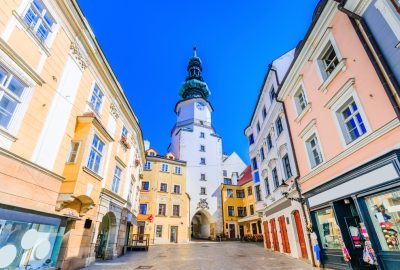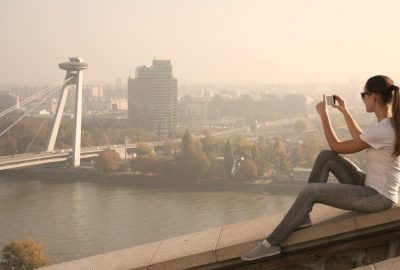Bratislava became the Slovakian capital in 1993, following its separation from Czechoslovakia. They joined the EU 11 years later and quickly became one of the most prosperous European countries. First signs of a settlement are from 2nd century AD and of course it were the Romans. Afterwards the Slavs hanged out for a while and Magyars took over for almost a millennium. This former military fortress town had less than 6000 citizens, back in the 14th century when the city’s first university was established. It grew exponentially and is now home to around 450 000, which is still small compared to the rest of European capitals. It is a charming city, especially for people that enjoy exploring museums and taking in rich church interiors and religious art. Most of the sights are located around the Old Town and its numerous squares. The most famous one is Hlavné Námestie, which literally means Main Square, the place where peddlers aim to sell of sorts of crap to malleable tourists. The entire area is very compact but filled with extravagant palaces, historic fountains and statues. You will probably come across several weddings, just because everyone wants to get married at the Old Town. Churches are booked for years to come, especially the characteristic Church of St. Elizabeth, commonly known as the Blue Church. Also, try to stay away from restaurants around the area, unless you’re cool with paying €3 for ketchup as a side to your €5 fries. A delicious burger with sides rarely costs more than €7 outside of the “Scam Old Town”.

Bratislava might not as big and popular as neighbouring Vienna or rival Prague but the Old Town is particularly charming; Michael's Gate is the last remaining gate from the medieval period
Bratislava shares many of its qualities with the rest of the post-communist era cities. While Paris is known as the “City of Eternal Love”, some consider Bratislava the “City of Not-So-Eternal Love”. People tend to change their minds, don’t they? The staple Old Town, historic centre of the city, is great but as soon as you leave that area you get bombarded with a chaotic mess of architecture. Imagine a medieval castle and a bridge that looks like it was taking straight out of a Star Trek movie in the same picture. I’m talking about the infamous UFO Bridge over the Danube, it’s actually pretty awesome, and you can even get on top of it for the best view of the city, especially during the night. Locals say the best view is from that bridge, because you can’t see the bridge itself, which just doesn’t fit to the surroundings.

The Bridge of the Slovak National Uprising (Most SNP), nicknamed UFO Bridge because of the shape of its observation deck, is the world's longest bridge with just one pylon and one cable-stayed plan
Bratislava won’t let you down if you’re into vistas and panoramas, Kamzik TV Tower is located in the middle of a forest, five minutes outside of city centre, the view is amazing and they even got one of those rotating restaurants, as the whole floor rotates clockwise while you’re eating. Personally I’m not sure if I could keep the food down in those circumstances. If you’re into that whole hipster culture, you’ll feel right at home in Bratislava. Slovaks spend their summer evenings at numerous bars and urban beaches on the banks of river Danube, but the city isn’t lacking in the regular club scene either, try KC Dunaj (https://www.kcdunaj.sk/) at Nedbalova 435/3 for a chill evening or The Club (https://www.theclubbratislava.com/) at Rybné námestie 4135/1 for a full on techno experience.
That’s the surface; underneath it all is an ancient, European city that does its best to catch up with the modern world. Vienna is nearby and Bratislava has a stellar role model to follow. It’s so close you can take a boat ride from one city to the other, which is especially great during summer. People say it’s one of the most enjoyable cities to explore on foot. Be it the Old Town and its maze-like little alleys, the Devin castle (only a 30 minute bus ride outside of Bratislava), or numerous museums if the weather gets unpleasant. A rare opera at the Slovak National Theatre is also quite an experience. It was actually the place where I saw the first opera of my life: La Bohème, composed by Giacomo Puccini. It was an amazing experience and at the point of some aria my female company couldn’t control herself anymore and she burst into to tears. I still remember how surprised I was because she was from the Nordic countries and I always thought these people are pretty “cool”. So it turned out she was very passionate and dared to show her emotions, which is a big plus in my book.
If you would have time for a trip outside the city, you should definitely visit the Danubiana Meulensteen Art Museum, located in Čunovo, about 15 kilometers south of Bratislava. It is one of the youngest contemporary art museums in Europe and its exhibitions and permanent collection include beautiful pieces by renowned Slovak and international artists. The location of the museum is a work of art in itself: on the edge of a peninsula where the impressive Danube flows and where the three countries of Slovakia, Austria and Hungary meet. From the roof terrace you have an amazing panoramic view and when the weather allows you definitely should also stroll around in the surrounding park, which is home to around 60 great sculptures.



No one commented yet. Be the first.